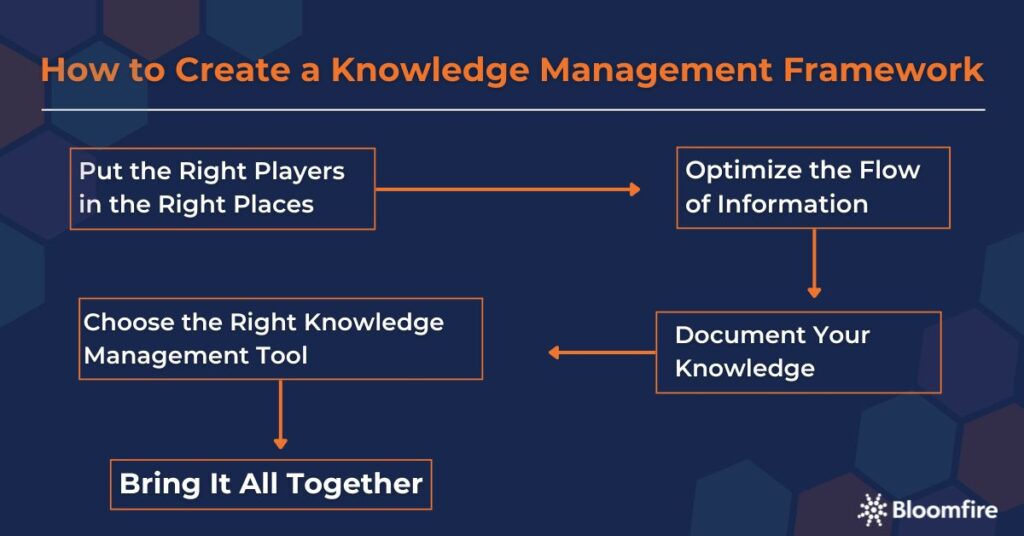How to Create an Organization Knowledge Management Framework

Here’s a reality organizations ought to know: without effectively documenting, sharing, and retaining the knowledge within your business, it’s nearly impossible to create a positive and productive culture. It will also be challenging to hold onto top talent and deliver a top-quality experience to your customers. The good news is you can undertake these initiatives by first developing a knowledge management (KM) framework.
In this guide, we’re delving into the fundamentals of this framework so you can begin creating your KM processes or optimizing existing methods to better support your organization.
What Is a Knowledge Management Framework?
A knowledge management framework is a structure or system designed to create, manage, and distribute different forms of organizational knowledge and resources. This framework encompasses the technology and structure an organization uses to facilitate knowledge sharing, the leaders supporting it, and the processes it develops to manage knowledge assets.
A knowledge management strategy framework supports everything knowledge-related, including:
- Information found in an employee handbook
- Step-by-step instructions for using different software programs
- Responses to customers’ FAQs
- Market research critical to high-stakes decision-making in the organization
In essence, a well-defined knowledge management structure is the backbone of an informed and agile organization. It can empower employees to make well-informed decisions, foster collaboration, and cultivate a culture of innovation.
What Makes a Knowledge Management Framework So Effective?
An operative knowledge management framework streamlines information and critical data that guide employees and leaders in navigating business processes and concerns. For example, it supports comprehensive onboarding, which speeds up training and helps employees excel and feel more capable of performing their roles.
According to a study by Glean, new hires often feel bombarded with information during onboarding, with 81% reporting feeling overwhelmed due to fragmented digital tools and scattered resources. However, this problem can be avoided if a KM framework is implemented.
A practical knowledge management framework also breaks down information silos and reduces the time employees spend recreating existing solutions to problems. In addition, it empowers employees to work more efficiently and productively.
5 Steps to Creating a Knowledge Management Framework
The main elements of a knowledge management system are the key pillars to ensure the framework’s effectiveness. Understanding the structure of knowledge management systems is essential for effectively organizing and utilizing information within an organization.
These five KM system elements are people, process, content, technology, and strategy. Optimizing them allows you to create a practical KM framework that fills any existing knowledge gaps.
Here are the key steps to formulating a knowledge management framework based on the critical elements of a KM system.

1. Put the Right Players in the Right Places (People)
Every team will benefit from effective knowledge management, but starting with a few key advocates is ideal. For your knowledge management framework to work, you select the right leaders and champions. That’s why the first step in your process is delegating the people responsible for helping build and successfully implement your KM strategy.
Start by identifying senior leaders for whom knowledge management would be a big win—such as the heads of departments like HR, IT, sales, marketing, customer insights, and customer service. These senior stakeholders will not only help you roll out your KM efforts and identify areas for improvement, but they will also help champion the cause across the organization.
As your KM matures, you’ll also want to select someone from each department or team to ensure all the information you share is accurate and up-to-date. They will ensure tacit knowledge retention when veteran employees change roles or move on from the organization. Additionally, you’ll need to determine who is responsible for introducing new hires to the knowledge management process and how to access the information they need.
2. Optimize the Flow of Information (Process)
The second component of the framework is the process—how you collect, share, and manage knowledge. Your KM framework should make accessing information easier as your workforce is more likely to use it.
To do this, you must decide what type of information you want to make available. Next, you need to determine how people can access this information. The best way to ensure success is by investing in a KM solution, particularly one that has the following attributes:
- Accessible from anywhere: Look for a solution that’s cloud-based and mobile-friendly. This is especially critical for organizations with employees who travel often, work remotely, or follow a hybrid model. Every workforce member should be able to access information from anywhere and anytime.
- User-friendly: The KM software you choose should be easy to use and have useful features like search functionality and rich publishing so you can add charts, videos, and more.
- Highly secure: Some of the information you’re adding will be sensitive and confidential, so you must select technology that contains layers of security and complies with data protection measures.
- With advanced tools: To get the most out of your KM system, make sure it has advanced features like artificial intelligence (AI)-powered tools, robust analytics, and reporting capabilities.
As part of your pre-launching phase, let a few teams or business units do a pilot test to iron out any kinks in the process before you bring the entire organization aboard. Address any issues that arise to minimize complications when orienting and training your teams.
3. Documenting Your Knowledge (Content)
Content is any kind of documented knowledge in the context of KM. As part of your knowledge management methodology framework, you need to ensure the following actions:
- Determine how you will compile and document it. Form a protocol in writing and make it a part of your orientation.
- Create a detailed process to guarantee consistent knowledge regarding type, structure, and value. For example, if you decide on a taxonomy and naming conventions for standardization, it will be easier to map out the content and determine related assets.
- Make sure the content is scannable and readable. If your KM platform supports thumbnails, including a critical visual can help employees quickly identify relevant content from a search results page.
- Schedule time-sensitive content to be reviewed or archived once it goes out of date. Otherwise, your knowledge base can become cluttered, making it more challenging for people to find what they need.
- Consider designating content moderators. If your knowledge base contains extensive formal documentation, they will be in charge of reviewing and approving content before it’s published.
Following these steps will help guarantee everything that goes live on the platform is accurate and complies with your organization’s standards. Additionally, this process will enhance your content’s overall trust and reliability among users.
4. Choosing the Right Knowledge Management Tool (Technology)
The right knowledge management technology will support your framework and make it easy for employees to tap into your company’s knowledge whenever needed. When choosing a KM system, look for features such as the following:
- An AI-powered search engine
- Content engagement analytics
- Configurable content feeds
- The ability to assign roles and permissions
- Automated content scheduling and unpublishing
Evaluate each feature based on its value to your organization. Most importantly, consider how you will integrate the KM solution with existing IT infrastructure and applications.
5. Bring It All Together (Strategy)
Your strategy is the final piece of the puzzle for effective knowledge management. It’s all about aligning your KM initiatives with your organization’s strategy. It’s important to know that without a clear, business-aligned strategy, sustaining success can be challenging, even with the best tech, the most talented workforce, and top-notch content.
Take time to document the above components—from the people and roles you need to identify and the content you’ll develop to the technology and solutions you’ll use to execute the processes.
It’s also good to create a value proposition for your knowledge management efforts and set key performance indicators (KPIs), such as:
- Employee time saved
- Employee satisfaction
- Reduction in errors or duplicate work
- Reduction in onboarding time
Tracking these KPIs helps you calculate your knowledge management’s return on investment (ROI). It allows you to identify areas for improvement and optimize your KM strategies for better outcomes.
Overcome Knowledge Silos with a Framework
Building knowledge management into a strategy framework can be complex—especially for larger companies with a wealth of information siloed within teams. But by leveraging a knowledge management framework, you can help cultivate better knowledge-sharing habits, ensure everyone has access to the information they need, and overcome some of your organization’s biggest challenges.
This blog post was first published in May 2021. It was most recently updated and expanded in December 2024.
Craft Your Organization’s KM Framework
Empower your teams and boost efficiency with a robust knowledge management system.
Get Our Guide

A SharePoint Alternative That Unlocks Enterprise Intelligence

What Is Enterprise AI Search? (And Why Your Business Needs It)

The Value in Knowledge Sharing Sessions

Start working smarter with Bloomfire
See how Bloomfire helps companies find information, create insights, and maximize value of their most important knowledge.

Take a self guided Tour
See Bloomfire in action across several potential configurations. Imagine the potential of your team when they stop searching and start finding critical knowledge.